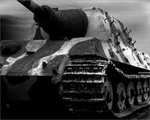davebender
1st Lieutenant
Jagdpanzer IV. Entered production January 1944.

24 tons. 300hp engine.
Simple leaf spring suspension.
7.5cm/48 main gun. Plus one or two machineguns.
60mm frontal armor. Nicely sloped.
6.85m long x 3.17m wide x 1.85m high.
…..Suspension aside I think this vehicle was state of the art at the time it entered service. Main gun could defeat contemporary threats. Very low profile plus excellent armor made it difficult to kill with weapons available during 1944. Unlike the 15 ton Hetzer this vehicle was large enough to allow ample crew space. Power to weight ratio similar to many contemporary armored vehicles and it was mechanically reliable. Like the Hetzer it was designed for inexpensive mass production.
Kanonenjagdpanzer. Entered service 1965.

27.5 tons. 500hp engine.
Torsion bar suspension.
9cm/40 main gun. Plus two machineguns.
50mm frontal armor. Nicely sloped.
6.24m long x 2.98m wide x 2.09m high.
…..Would this vehicle be competitive vs T-62 tanks? I have my doubts. It may be a Jagdpanzer too far.
24 tons. 300hp engine.
Simple leaf spring suspension.
7.5cm/48 main gun. Plus one or two machineguns.
60mm frontal armor. Nicely sloped.
6.85m long x 3.17m wide x 1.85m high.
…..Suspension aside I think this vehicle was state of the art at the time it entered service. Main gun could defeat contemporary threats. Very low profile plus excellent armor made it difficult to kill with weapons available during 1944. Unlike the 15 ton Hetzer this vehicle was large enough to allow ample crew space. Power to weight ratio similar to many contemporary armored vehicles and it was mechanically reliable. Like the Hetzer it was designed for inexpensive mass production.
Kanonenjagdpanzer. Entered service 1965.
27.5 tons. 500hp engine.
Torsion bar suspension.
9cm/40 main gun. Plus two machineguns.
50mm frontal armor. Nicely sloped.
6.24m long x 2.98m wide x 2.09m high.
…..Would this vehicle be competitive vs T-62 tanks? I have my doubts. It may be a Jagdpanzer too far.


